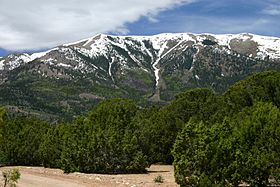Henry Mountains
| Henry Mountains | |
|---|---|

Peaks in the Henry mountains viewed from a high mountain road
|
|
| Highest point | |
| Peak | Mount Ellen |
| Elevation | 11,522 ft (3,512 m) |
| Coordinates | 38°6.53′N 110°48.82′W / 38.10883°N 110.81367°WCoordinates: 38°6.53′N 110°48.82′W / 38.10883°N 110.81367°W |
| Geography | |
| Country | United States |
| State | Utah |
| Parent range | Rocky Mountains |
| Geology | |
| Type of rock | igneous |
The Henry Mountains are located in the southeastern portion of the U.S. state of Utah and run in a generally north-south direction, extending over a distance of about 30 miles (50 km). They were named by Almon Thompson in honour of Joseph Henry, the first secretary of the Smithsonian Institution. The nearest town of any size is Hanksville, Utah, which is north of the mountains. The Henry Mountains were the last mountain range to be added to the map of the 48 contiguous U.S. states (1872), and before their official naming by Powell, were sometimes referred to as the "Unknown Mountains." In Navajo, the range is still referred to as Dził Bizhiʼ Ádiní ("mountain whose name is missing").
The range is clustered into two main groups, with Highway 276 dividing the two portions. The northern group is by far the taller of the two with Mount Ellen: 11,522 feet above sea level; Mount Pennell: 11,371 feet; and Mount Hillers: 10,723 feet. The southern group is much lower in elevation. The southern group has two peaks: Mount Ellsworth: 8,235 feet and Mount Holmes: 8,000 feet. The southern group is also known as the "Little Rockies".
The Henry Mountains are drained by a number of canyon systems which radiate away from the isolated range, flowing north into the Fremont River, east into the Dirty Devil River, or south into Lake Powell.
The geology of these mountains was first studied in 1875-1876 by Grove Karl Gilbert. He coined the term "laccolite" (now laccolith) to describe the characteristic shapes of some of the igneous intrusions that core the mountains. The main type of igneous rock is porphyritic diorite.
...
Wikipedia

